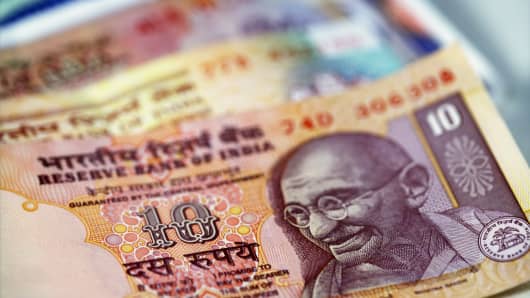The Reserve Bank of India (RBI) lowered its key policy rate for the second time this year on Tuesday, but will the central bank's latest move succeed in helping revive growth in Asia's third largest economy, which is languishing at multi-year lows?
According to Jahangir Aziz, chief India economist at JPMorgan, the latest round of monetary policy easing will do little in the way of reigniting the investment cycle and growth in India.
"At the margin, it makes people feel better (and) the asset markets will clearly welcome it. Whether or not this jumpstarts the investment cycle - doubtful," Aziz told CNBC on Tuesday.
The central bank cut its benchmark interest rate by 25 basis points to 7.5 percent, in line with market expectations. This followed a similar move in January, when the RBI too lowered borrowing costs by 0.25 percent, in addition to a 0.25 percent cut in banks' cash reserve requirement (CRR). This time it made no change to the CRR ratio.
(Read More: India's Central Bank Cuts Key Interest Rate )
"Interest rates are not really the binding constraint for investment. The fact that growth hasn't picked up and the government's approval process hasn't gone back to the pre-2008 levels, those are the much bigger concerns," Aziz added.
Growth in investment - which makes up around 35 percent of gross domestic product (GDP) in India - has slowed sharply in recent years owing to a host of issues, ranging from lengthy approval processes and infrastructure bottlenecks as seen with the nation's biggest-ever power outage in July 2012.
Investment growth, which was 16 percent in the fiscal year ended March 31 2006, fell to an estimated 3 percent in the current financial year during which India is expected to clock GDP growth of around 5 percent.
(Read More: Has India's Economy Turned a Corner? )
Rajiv Mallik, senior economist at brokerage, CLSA said, "If you think a small interest rate reduction will fix India's growth, it is wishful thinking."
The 25 basis point rate cut "will be incrementally helpful but not a game changer," he said.
Mallik added that the central bank will be unable to cut "as much as they need to" because inflation is still a concern. The wholesale price index (WPI), the main inflation indicator, rose an annual 6.84 percent in February, above the 6.54 percent rise forecast by analysts. Wholesale prices climbed 6.62 percent in January.
(Read More: Indian Inflation Picks Up )
In its statement following the rate decision, the RBI said headroom for further monetary easing remains "quite limited," noting that inflation is likely to remain around current levels throughout the coming fiscal year that begins in April. Indian equity markets reacted negatively to this hawkish tone, with the benchmark Bombay Sensex trading down 1.3 percent following the announcement.
Another dampener for markets was the fact that the central bank did not cut the CRR ratio, which according to Vijayalakshmi Iyer, managing director of Mumbai-based Bank of India, would make it difficult for banks to pass this rate cut on to consumers.
"The policy is very much on expected lines, but to what extent we will be able to transmit is a question we need to look at," Iyer said on CNBC TV-18.
Indian banks are facing tight liquidity conditions because deposit growth has hit a decade low, according to Citi, in part due to slower economic growth and high inflation.
"A reduction in the cost of funds always comes with a lag. As of now, we are also facing tightness in raising the pace of deposit growth. Given the circumstance, immediate transmission may not be possible, we may need to wait for a month or two to look into how much we can do," she added.



